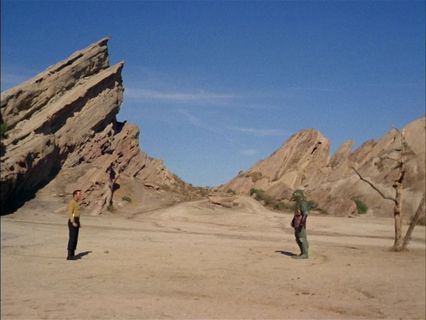Extreme stories in extreme conditions. Essay. 800 words, 4-minute read.

Sci Fi Weather
By Ray Tabler
There’s an old joke that all alien planets look like Southern California. This is a snarky hat tip to Hollywood’s tendency to film at convenient nearby locations. Iconic among those was (and is) Vasquez Rocks, between Santa Clarita and Palmdale, California. The above image is from the Star Trek episode Arena, when Captain Kirk and the Gorn squared off in a battle nearly to the death.
It is completely understandable that studios seek to minimize costs by shooting close to home. Cast and crew all live locally. The distance to haul filming equipment is relatively short. And movie ranches are familiar with the business.
An unintended consequence, however, is that viewers end up seeing the same set of rocks in multiple movies and TV shows. Various techniques are employed to minimize recognizability (lighting, framing, camera angles). If the story’s good enough, you don’t notice. But sometimes that’s all you see.
What’s more obvious is the arid setting of sci fi shows and movies. Hence, alien planets on the screen tend to be… deserty. Planet of the Apes (1968). Them (1954). The Monolith Monsters (1957). Like the men the British 8th Army and Afrika Korps in World War II, film makers also prefer the desert, because there’s nobody in the way. A scene in the medieval-set Braveheart was famously ruined by a truck driving along a road in the background.
The trend continues when filming isn’t carried out near Hollywood. The Mad Max movies take place in a post-apocalyptic Australian outback. Both versions of Westworld spend a lot of time in the sandbox. Tremors is set in the isolated community of Perfection, Nevada.
This preference for a desert setting has become a creative choice. It conveys the desolation of a post-apocalyptic story on a subliminal level. Arid surroundings focus the viewer’s attention right where the director intends, on the characters instead of a distracting background. And a desert is unfamiliar to most people, adding an otherworldly aspect to a story without spending one red cent on special effects.
Forbidden Planet was filmed entirely on sound stages. Yet, the movie is set on the desert world of Altair IV. Which was a decision by the director and set designers. To be honest, it probably cost a lot less to build a sandy set for filming than one full of fake jungle plants.
Even before movies were invented, Edgar Rice Burroughs set his Barsoom novels on Mars. That was heavily influenced by the erroneous observation by astronomers of canals on Mars. Turned out to be an issue with telescope technology of the day, and wishful thinking. Sort of the early 20th century version of the flat earth theory. Burroughs spun the misunderstanding into a dying, desert world, channeling dwindling moisture from polar ice caps to cities on the shores of dead seas, drawing upon his experiences as a cattle hand on an Arizona ranch.
An opposite approach sets the story in a frigid environment. The Arctic, or Antarctic is simply a desert with a frosty windchill. The same isolating, focusing, foreboding atmosphere emanates from the screen. The Thing From Another World (1951), and its remake The Thing (1982), tell of a hostile alien visitor stalking people, and being stalked, in a lonely outpost. Help from outside is not an option.
Another example is Quintet (1979), an odd, unsettling movie set in a future ice age, when people focus only on survival and playing an all-consuming game, on a dying Earth. Quintet was Paul Newman’s only science fiction movie. Although, The Silver Chalice was surreal enough to come close. And, he did appear in a TV episode, titled ironically, Ice From Space.
Starting in the 1980s, the city of Vancouver sought to incubate a local film industry through tax incentives. To a large degree, it worked, earning the locality the nickname “Hollywood of the North.” So, for a while, some alien planets looked like the pacific northwest, instead of the movie ranches around Los Angeles. Notable examples are the Stargate and Supernatural TV series, and the latest reboots of Planet of the Apes franchise, like Rise of the Planet of the Apes.
The extreme weather in sci fi movies and series rests upon a three-legged stool: creative choice, filming costs & logistics, and audience expectations. Directors use the isolating, and mood-setting techniques of desolate surroundings to keep the audience’s attention on the story. Studios sought to cut costs by limiting travel, which kept filming locations on a leash near Los Angeles. And, after a while, the viewing public came to expect alien planets to be, basically, deserts of some kind or another. Fire or ice, sci fi tends to be set in extreme conditions.
END.
Reference links:
· Arena https://en.wikipedia.org/wiki/Arena_(Star_Trek:_The_Original_Series)
· Braveheart https://www.moviemistakes.com/film207
· Martian canals https://en.wikipedia.org/wiki/Martian_canals
· Quintet https://www.imdb.com/title/tt0079770/
· Ice From Space https://www.imdb.com/title/tt0717034/
· The Silver Chalice https://www.imdb.com/title/tt0047494/?ref_=nm_flmg_job_1_cdt_t_74
Shameless Self-Promotion Section:
Check out my novels at Histria Books https://histriabooks.com/product-tag/ray-tabler/
- The Diesel-Powered Starship (due for release in September 2025) https://histriabooks.com/product/the-diesel-powered-starship/
- A Grand Imperial War (Book 1 of the Grand Imperial series) https://histriabooks.com/product/a-grand-imperial-war-grand-imperial-series-book-1/
- A Grand Imperial Heir (Sequel to A Grand Imperial War) https://histriabooks.com/product/a-grand-imperial-heir-grand-imperial-series-book-2/
- Fool’s Paradise https://histriabooks.com/product/fools-paradise/
And visit my website https://raytabler.com/ for Science Fiction You Can Enjoy!
